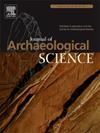贝类在加纳的运输:通过几何形态计量学揭示的光滑扇贝Flexopecten glaber的古生物地理学、来源和贸易
IF 2.6
1区 地球科学
Q1 ANTHROPOLOGY
引用次数: 0
摘要
光滑的扇贝(Flexopecten glaber)是一种海鲜,在罗马时代在加利亚纳博纳斯(法国南部)广泛消费。从地中海沿岸的泻湖捕捞,这些物种被运送到距离海岸100公里的消费者手中。然而,这种供应给高卢罗马人的新鲜农产品的来源在很大程度上仍然未知。从公元前1世纪到公元12世纪,来自法国南部27个考古遗址的1149个贝壳的大小和形状变化使用椭圆傅里叶变换进行量化,并通过几何形态计量学进行分析。扇贝壳的形态测量学在地理上是高度结构化的,显示出不同时期的泻湖之间的差异。这种考古生物地理学模式可以估计在腹地发现的阀门的地理起源,并重建海洋资源供应中心。虽然大多数阀门都尽可能靠近消费地采购,但来自Nemausus市(n本文章由计算机程序翻译,如有差异,请以英文原文为准。
Transport of seashells through Gallia Narbonensis: Archaeobiogeography, provenance and trade of smooth scallop Flexopecten glaber revealed through geometric morphometrics
The smooth scallop (Flexopecten glaber) is a seafood that was widely consumed in Gallia Narbonensis (Southern France) during Roman times. Harvested from lagoons along the Mediterranean coast, the species was transported to consumers up to a hundred kilometres from the seashore. However, the origins of this fresh produce supplied to the Gallo-Romans remain largely unknown. The variation in size and shape of 1149 shells originating from 27 archaeological sites in Southern France, dating from the 1st c. BC to the 12th c. AD, was quantified using Elliptic Fourier Transforms and analysed through geometric morphometrics. The morphometry of scallop shells is highly structured geographically, showing differences between lagoons of origin regardless of the period. This archaeobiogeographical pattern allows for the estimation of the geographical origin of valves discovered in the hinterland and the reconstruction of marine resource provisioning centres. While most valves were sourced as close as possible to the place of consumption, the exception of the smooth scallops from the city of Nemausus (Nîmes) reveals a structured network dedicated to urban supply. Future research could extend these methodologies to a broader geographical scope, providing a more detailed analysis of trade and supply networks of Mediterranean shellfish.
求助全文
通过发布文献求助,成功后即可免费获取论文全文。
去求助
来源期刊

Journal of Archaeological Science
地学-地球科学综合
CiteScore
6.10
自引率
7.10%
发文量
112
审稿时长
49 days
期刊介绍:
The Journal of Archaeological Science is aimed at archaeologists and scientists with particular interests in advancing the development and application of scientific techniques and methodologies to all areas of archaeology. This established monthly journal publishes focus articles, original research papers and major review articles, of wide archaeological significance. The journal provides an international forum for archaeologists and scientists from widely different scientific backgrounds who share a common interest in developing and applying scientific methods to inform major debates through improving the quality and reliability of scientific information derived from archaeological research.
 求助内容:
求助内容: 应助结果提醒方式:
应助结果提醒方式:


